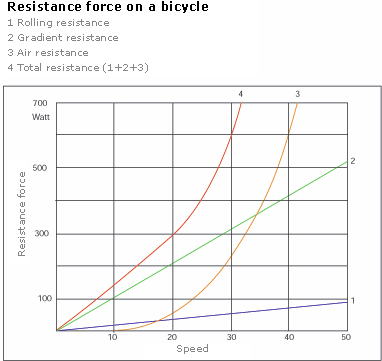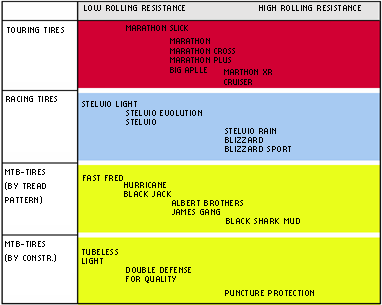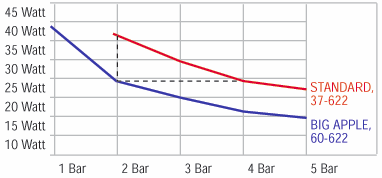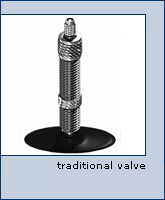

Understanding your tires
Published on 08/06/2007
Your tires are an important part of your trike, and choosing the right tire can make a big difference. We carry the full line of Schwalbe tires and accessories, and always try to keep the entire 406-size recumbent tires in stock. Get some insight into what goes into the right tire:
FAQs from Schwalbe
Fitting - What is the correct way to fit a tire?
- All spoke holes must be completely and securely covered with an appropriate rim tape.
- Observe any rolling direction markings on the tire sidewall.
- Never use sharp fitting tools.
- Pull one tire side onto the rim (fig.1)
- Slightly inflate the tube until it is round.
- Fit the valve through the valve hole in the rim.
- Place the tube into the tire. (Fig. 2)
- Starting at the opposite side to the valve fit the other tire side onto the rim.
- Ensure the tube is not pinched between the rim and the tire.
- The valve should be in an upright position.
- Center the tire before inflating it to the required pressure.
- Adjust the inflation pressure using a pressure gauge, e.g. the AIRMAX pressure gauge. The permissible pressure range is marked on the tire sidewalls. The higher the inflation pressure, the lower the rolling resistance, the tire wear and the less likelihood of a puncture.
- The inflation pressure should be checked at least once a month.
Fitting - Why is it sometimes so difficult to fit a tire?
Fitting difficulties often arise when the diameters of the rim and the tire do not match perfectly.
Rims can have a diameter tolerance of +/- 0.5 mm. In addition, each rim flange height can also have a tolerance of +/- 0.5 mm. These figures add up to a total diameter tolerance of +/- 1.5 mm, or 4.7 mm over the circumference. This corresponds to a maximum possible circumferential difference of 9.4 mm between the largest and the smallest rim.
A tire has to fit on both extremes, so because a safe fit has to be ensured even on the smallest permissible rim diameter, the proper centering of the tire on the largest permissible rim can prove quite difficult.
The circumferential tolerance of SCHWALBE tires is +/- 1mm.
Inflation - How often should tire pressures be checked?
The inflation pressure should be checked and adjusted at least once a month. Even the best tubes constantly lose pressure as, contrary to car tires, the pressure required in bicycle tires is much higher and wall thickness is much thinner. A pressure loss of 1 bar per month can be viewed as normal, but pressure loss will be much faster if high inflation pressures are used and much slower when low inflation pressures are preferred.
When using latex tubes, it is best to check and adjust inflation pressures before every ride.
Use a pressure gauge to monitor inflation pressure. The widespread thumb-test method is very inaccurate as all tires will feel identically hard from a pressure of 2 bar up.
Inflation - What is the correct inflation pressure for my tire?
It is impossible to make a general recommendation on inflation pressure for a specific bicycle or a particular tire. The “right” inflation pressure depends mainly on the load exerted on the tire. This weight is mainly influenced by the weight of the rider and any luggage. Contrary to a car, the vehicle weight is only a minor part of the total weight. In addition there is a great diversity of individual preferences with regard to low rolling resistance or suspension comfort.
The permitted inflation pressure range is marked on the tire sidewall. Remember that the higher the inflation pressure, the lower are the rolling resistance, wear and likelihood of a puncture. The lower the inflation pressure, the higher are the comfort and grip that the tires provide.
The list of inflation pressure recommendations on the right can only provide a very general guide. The recommendations are for an “average rider” weighing about 75 kg.
If you are heavier or carry luggage, you should chose a higher inflation pressure. You can also increase the inflation pressure if you prefer lower rolling resistance. It is recommendable that higher inflation pressures are used on very small diameter tires such as low profile race bikes and folding bikes.
Lighter weight riders or riders who prefer a comfortable ride can chose an accordingly lower inflation pressure, but the actual tire pressures should never be higher or lower than the maximum and minimum inflation pressures marked on the tire sidewall.
Inflation - Why is inflation pressure so important in bicycle tires?
Only a tire with sufficient inflation pressure can bear the weight of a bicycle. The higher the inflation pressure, the lower the rolling resistance and higher pressure also reduces the likelihood of a puncture.
Long-term, under-inflation often leads to premature tire wear and aging, commonly resulting in sidewall cracking and increased tire wear.
On the other hand, an under-inflated tire absorbs road shocks better.
Wide tires are generally used at low pressure. The advantages are that the large air volume absorbs road bumps and holes without the drawbacks of high rolling resistance, less puncture protection and tire wear.
Rolling Resistance - What exactly is rolling resistance?
Rolling resistance is the energy that is lost when the tire is rolling and the main reason for loss of energy is the constant deformation of the tire.
In addition to rolling resistance, there are also other resistances that have to be overcome when riding a bicycle.
Air resistance rises squared with increased speed. At a straight-line speed of 20 km/h on the flat, air resistance is the main resistance force.
Energy is also required to accelerate. For instance, the weight of the wheels is of great importance when this mass has to be brought up to rotation.
When riding uphill, the main resisting force to overcome is the gradient resistance (descending force).
In addition to these, there are other friction resistances in the chain and all of the other moving parts. Yet in a well-serviced bicycle, these represent a very minor part of the total resistance.
Rolling Resistance - Which factors affect rolling resistance?
Tire pressure, tire diameter, tire construction, tire tread and other factors all have an effect on rolling resistance.
The higher the tire pressure, the less is tire deformation and thus the rolling resistance.
Small diameter tires have a higher rolling resistance at the same tire pressure, because tire deformation is proportionally more important, in other words the tire is “less round”.
Wider tires roll better than narrow ones. This assertion generally generates skepticism, nevertheless at the same tire pressure a narrow tire deflects more and so deforms more.
Obviously, tire construction also has an effect on rolling resistance. The less material is used, the less material there is to deform. And the more flexible the material is, such as the rubber compound, the less energy is lost through deformation.
Generally, smooth treads roll better than coarse treads. Tall lugs and wide gaps usually have a detrimental effect on rolling resistance.
Rolling Resistance - Which SCHWALBE tire has the lowest rolling resistance?
The rolling resistance of a tire should not be overestimated, as it is only a part of the total resistance. In addition, the correct inflation pressure has a much greater influence on rolling resistance than the tire structure.
In order to make a tire with very low rolling resistance, it is necessary to compromise on other important factors such as puncture protection or grip.
The following gives a rough overview of tires and their relative rolling resistance. A direct comparison is impossible though, as the tires have different widths and some are used with very different inflation pressures. 
Rolling Resistance - Why do Pros ride narrow tires if wide tires roll better?
Wide tires only roll better at the same inflation pressure, but narrow tires can be inflated to higher pressures than wide tires. However, they then obviously give a less comfortable ride.
In addition to this, narrow tires have an advantage over wide ones at higher speeds, as they provide less air resistance.
Above all, a bicycle with narrow tires is much easier to accelerate because the rotating mass of the wheels is lower and the bicycle is much more agile.
At constant speeds of around 20 km/h, the ride is better with wider tires. In practice, the energy saving is even greater than in theory as the elasticity of the tires absorbs road shocks, which would otherwise be transferred to the rider and so saves energy.
Rolling Resistance - Why do wide tires roll better than narrow ones?
The answer to this question lies in tire deflection. Each tire is flattened a little under load. This creates a flat contact area.
At the same tire pressure, a wide and a narrow tire have the same contact area. A wide tire is flattened over its width whereas a narrow tire has a slimmer but longer contact area.
The flattened area can be considered as a counterweight to tire rotation. Because of the longer flattened area of the narrow tire, the wheel loses more of its “roundness” and produces more deformation during rotation. However, in the wide tire, the radial length of the flattened area is shorter, making the tire “rounder” and so it rolls better.
Tire Construction - What is a tire made of?
There are three basic parts to a bicycle tire, the carcass, the bead core and the rubber tire tread. Furthermore, almost all SCHWALBE-tires have a puncture protection belt.
The carcass is a rubberized textile fabric, which is laid around the bead cores. The carcass is then coated with a rubber compound. The tire tread is applied and the whole assembly is vulcanized.
The bead core of the tire determines its diameter and ensures a secure fit on the rim. Generally the bead core of a tire is made of steel wire.
In folding tires, the steel wire is replaced with a hoop of Kevlar fiber. The advantage is that the tire can be folded and that, depending on the size, its weight can be reduced by 50 to 90 g.
All SCHWALBE carcasses are made of nylon. The density of the carcass fabric is expressed in EPI or TPI (Ends Per Inch, Threads Per Inch). The range of carcasses used for SCHWALBE tires are 24, 37, 50, 67 and 120 EPI.
Generally, tires with denser fabric are more resistant to punctures and roll better. Yet the ultra-fine 120 EPI carcass is more susceptible because the individual filaments are very fine. The best compromise for low weight and resistance is around 50 to 67 EPI.
The rubber compound of a tire is composed of several components:
Natural and synthetic rubber
Fillers, e.g. carbon black, chalk, silica
Softeners, e.g. oils and greases
Anti-ageing agents (aromatic amines)
Vulcanizing aids, e.g. sulphur
Vulcanization accelerators; e.g. zinc oxide
Pigments and dyes
Depending on the compound, the composition is roughly 40 - 60 % rubber, 15 - 30 % fillers, with the other components accounting for the rest.
Almost all SCHWALBE tires have a puncture protection belt, though we purposely decided not to include them in the special light and sports tires.
Even our standard tires are equipped with an effective puncture protection belt made of natural rubber.
MARATHON-tires, with the proven combination of natural rubber and Kevlar fibers in the Kevlar®-MB-Belt ensures remarkably high puncture protection. Furthermore, our top of the range tires have highly efficient puncture protection systems which are specifically adapted to the particular requirements, for example Double-Defense® or SmartGuard®.
Tire Construction - Which is the best puncture protection belt?
The current state of the art is our SmartGuard®, the safest puncture protection belt on the market.
Other puncture protection systems like Double-Defense® or Kevlar®-MB-Belts provide a very high degree of puncture protection. The decisive advantage of the SmartGuard® is its effectiveness against objects that become embedded in the tread, that are rolled over at each turn of the wheel and will eventually perforate virtually any protection belt. When this happens, the thickness of the SmartGuard® proves its advantage as a drawing pin will simply remain stuck in the rubber without further harming the tire.
Tire Construction - Which is the best rubber compound?
A rubber compound must satisfy various requirements that are to some extent contradictory: low rolling resistance, good slip resistance, low wear, longevity, solid lugs (MTB).
The conflicting aims of low rolling resistance and good wet grip always attract particular attention. Good grip implies that the tire must “absorb” a lot of energy while low rolling resistance requires a tire compound with low energy consumption. A good compromise can be achieved with a filling agent like Silica, but another solution is the use of several rubber compounds in one tire such as Dual Compound Technology.
We offer universal compounds that, as far as possible, combine all relevant features, as well as special compounds where one feature is particularly prominent. The MARATHON 23S compound of is one of our universal compounds, while on the other hand the Marathon XR 1A compound is used to achieve very high mileage performance. Another example is the Maximum Grip Compound of the STELVIO RAIN.
Tire Tread - What do the direction arrows mean?
Most SCHWALBE tire sidewalls are marked with a “Drive” arrow, which indicates the recommended rolling direction. When in use, the tire should run in the direction of the arrow.
Many MTB tires are marked with a “Front” and a “Rear” arrow. The “Front” arrow indicates the recommended rolling direction for the front wheel and respectively the “Rear” arrow is the direction for the rear wheel.
Tire Tread - What does the tread do?
On a normal, smooth road, the tread has only limited influence on the ride properties. The grip generated by the tire on the road is almost exclusively the result of the rubber compound.
Unlike a car, a bicycle will not aquaplane as the contact area is so much smaller and the contact pressure is much higher. The floating effect of aquaplaning could only theoretically be achieved on a bicycle ridden at speeds over 200 km/h.
Off road, the tread is very important. In this situation the tread establishes an interlocking cog-like connection with the ground and enables the transmission of all driving, braking and steering forces.
On rough roads, the tread can also contribute to better control.
Tire Tread - Why are there so many tires with direction arrows?
In road tires, a tread with a rolling direction generally provides a slight reduction in rolling resistance. In addition to this, aesthetic considerations can also be important.
Off road, rolling direction is far more important, as the tread ensures optimum connection between the tire and the ground. The rear wheel transmits the driving force and the front wheel transmits the braking and steering forces. Driving and braking forces operate in different directions so this is why certain tires are fitted in opposite rolling directions when used as front and rear tires.
There are also treads without a specified rolling direction.
Tire Tread - Why ride a slick tire?
Even in wet conditions, on a normal, smooth road, a slick tire actually provides better grip than a tire with a tread, because the contact area is larger.
The situation is much different on a rough road and even worse on a dirt trail as in these cases the degree of control provided by a slick tire is extremely limited.
A slightly serrated surface on the tire tread can have a positive effect on tire grip, as it creates micro interlocking with rough asphalt.
Tire Tube - What is a bicycle tube made of?
A bicycle tube is predominantly made of Butyl rubber. Butyl is a very elastic and airtight synthetic rubber, but as with the tire, other fillers are necessary to make up the rubber compound. The quality of a tube can vary significantly depending on the rubber compound. For instance SCHWALBE tubes have very good air retention and are very elastic. This high elasticity allows a wide range of different tire sizes to be covered.
There is a difference between heat molded and autoclave tubes. Vulcanizing in a mould improves the uniformity of wall thickness, thus reducing weight and improving air retention. This is why the inferior yet more easily produced autoclave tubes have become increasingly less popular in recent years. SCHWALBE tubes have always been made using the heat molded process.
Every tube also needs a valve, which is bonded to the tube during the vulcanizing process.
Tire Types - What is a clincher tire?
These days clincher tires are the standard for bicycle tires (see tire construction). The wire tire bead prevents the tire from expanding with the pressure and thus from rolling off the rim.
Tire Types - What is a folding tire?
A folding tire is, in a way, a special version of the clincher tire (see tire construction, bead core). In this tire, the wire is replaced with a bundle of Kevlar fibers that allows it to fold easily and also makes the tire lighter by about 50 - 90 g.
Tire Wear - How long can a tire be stored?
SCHWALBE tires can be stored for up to 5 years without problem, but to attain this they should be stored in a cool, dry, and, most importantly, dark place. When stored properly, even longer storage times may be possible.
If fitted on a rim, tires should always be inflated or the wheel hung up for storage. A bicycle left on flat tires for an extended period may damage the tires’ sidewalls.
Tire Wear - What mileage can be achieved by the various tires?
It is difficult to answer this question, as tire mileage is influenced greatly by tire pressure, load, road surface, temperature and the rider. For example, when used in hot weather with a heavy load and on rough asphalt, a tire wears much faster.
As a general guide, you should expect a tire life of 2000 to 5000 km from SCHWALBE standard tires. Marathon type tires should generally last for 6000 to 12000 km. The MARATHON XR is an exception with its high mileage of about 8000 to 15000 km. With MTB tires, it is impossible to give a useful indication, as the individual riding style is the main determining wear factor. The Stelvio Competition tire should generally last 3000 to 7000 km.
Tire Wear - When is a tire worn out?
In bicycle tires the tread is far less important than for instance in car tires. So using a tire with a worn out tread is less of a problem, that is of course with the exception of MTB tires.
When the puncture protection belt or the carcass threads can be seen through the tread the tire has reached its wear limit and must be replaced. As the puncture resistance also depends on the thickness of the tread layer it may be useful to replace the tire earlier.
The sidewalls of tires often fail before the tread is worn out. In most cases, this premature failure is due to prolonged use of the tire with insufficient inflation pressure. Checking and adjusting the inflation pressure at least once a month with a pressure gauge is most important.
Valve - Which is the best valve?
There are three types that have become market standards and it is difficult to make any particular recommendation. The most important aspect is that the valve fits the rim valve hole and that an appropriate pump is available.
Contrary to popular belief, major air retention differences are now a thing of the past. In any event, SCHWALBE valves certainly provide excellent performance and are adapted to high-pressure use.
The traditional bicycle valve or Dunlop valve is still the most common worldwide and most cyclists are familiar with it.
The valve core is easily replaced and the air can be released very quickly.
Fitting a tube with a Dunlop valve is more awkward, as the valve core and locknut need to be removed in order to fit the valve through the valve hole. Inflation is only possible once the core and the nut are back in place.
With traditional Dunlop valves, it is impossible to check the inflation pressure. However, the special SCHWALBE Dunlop valve allows a return airflow, so that it is now possible to check the inflation pressure with an AIRMAX pressure gauge.
In former times it was difficult to inflate a tube with a Dunlop valves, but with today’s modern valve cores, this is no longer the case.
The Sclaverand valve at 6 mm instead of 8 mm is much smaller than other valves, requires a smaller valve hole and so is very well suited for racing bicycle rims.
It is also 4 - 5 g lighter than a car valve or Dunlop valve.
The top nut can be turned by hand and has to be opened before inflation, which surprises many first-time users. Also the thin top pin can be bent easily when attaching and removing the pump connector.
Be warned that using Sclaverand valves tubes on rims with larger valve holes often leads to valves shearing off when the sharp metal edges around the valve hole cut the valve stem off the tube.
The auto valve is becoming increasingly popular as it can easily be inflated at service stations and is very user friendly.
Older, as well as simple bicycle pumps are not compatible with auto valves.
The Regina valve looks very much like the French valve and is used almost exclusively in Italy. 




